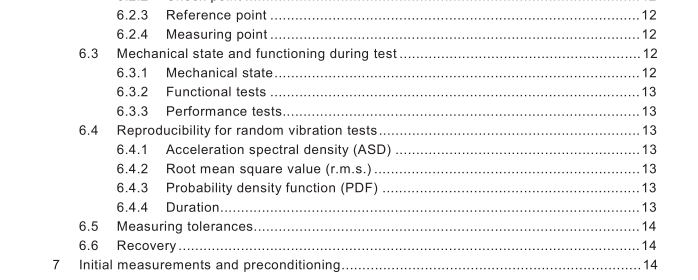EN 61373:2010 – Railway applications – Rolling stock equipment – Shock and vibration tests

1 Scope
This International Standard specifies the requirements for testing items of equipment intended for use on railway vehicles which are subsequently subjected to vibrations and shock owing to the nature of railway operational environment. To gain assurance that the quality of the equipment is acceptable, it has to withstand tests of reasonable duration that simulate the service conditions seen throughout its expected life. Simulated long-life testing can be achieved in a number of ways each having their associated advantages and disadvantages, the following being the most common:
a) amplification: where the amplitudes are increased and the time base decreased;
b) time compression: where the amplitude history is retained and the time base is decreased (increase of the frequency);
c) decimation: where time slices of the historical data are removed when the amplitudes are below a specified threshold value.
The amplification method as stated in a) above, is used in this standard and together with the publications referred to in Clause 2; it defines the default test procedure to be followed when vibration testing items for use on railway vehicles. However, other standards exist and may be used with prior agreement between the manufacturer and the customer. In such cases test certification against this standard will not apply. Where service information is available tests can be performed using the method outlined in Annex A.
If the levels are lower than those quoted in this standard, equipment is partially certified against this standard (only for service conditions giving functional test values lower than or equal to those specified in the test report). Whilst this standard is primarily concerned with railway vehicles on fixed rail systems, its wider use is not precluded. For systems operating on pneumatic tyres, or other transportation systems such as trolleybuses, where the level of shock and vibration clearly differ from those obtained on fixed rail systems, the supplier and customer can agree on the test levels at the tender stage.
It is recommended that the frequency spectra and the shock duration/amplitude be determined using the guidelines in Annex A. Equipment tested at levels lower than those quoted in this standard cannot be fully certified against the requirements of this standard.
An example of this is trolleybuses, whereby body-mounted trolleybus equipment could be tested in accordance with category 1 equipment referred to in the standard. This standard applies to single axis testing. However multi-axis testing may be used with prior agreement between the manufacturer and the customer. The test values quoted in this standard have been divided into three categories dependent only upon the equipment’s location within the vehicle.
EN 61373:2010 – Railway applications – Rolling stock equipment – Shock and vibration tests